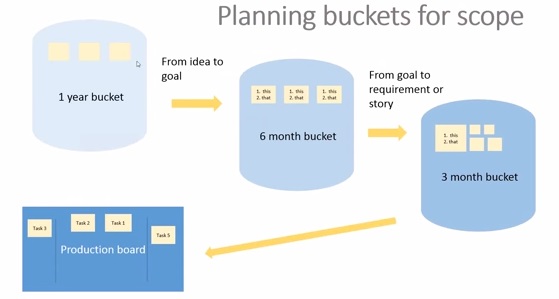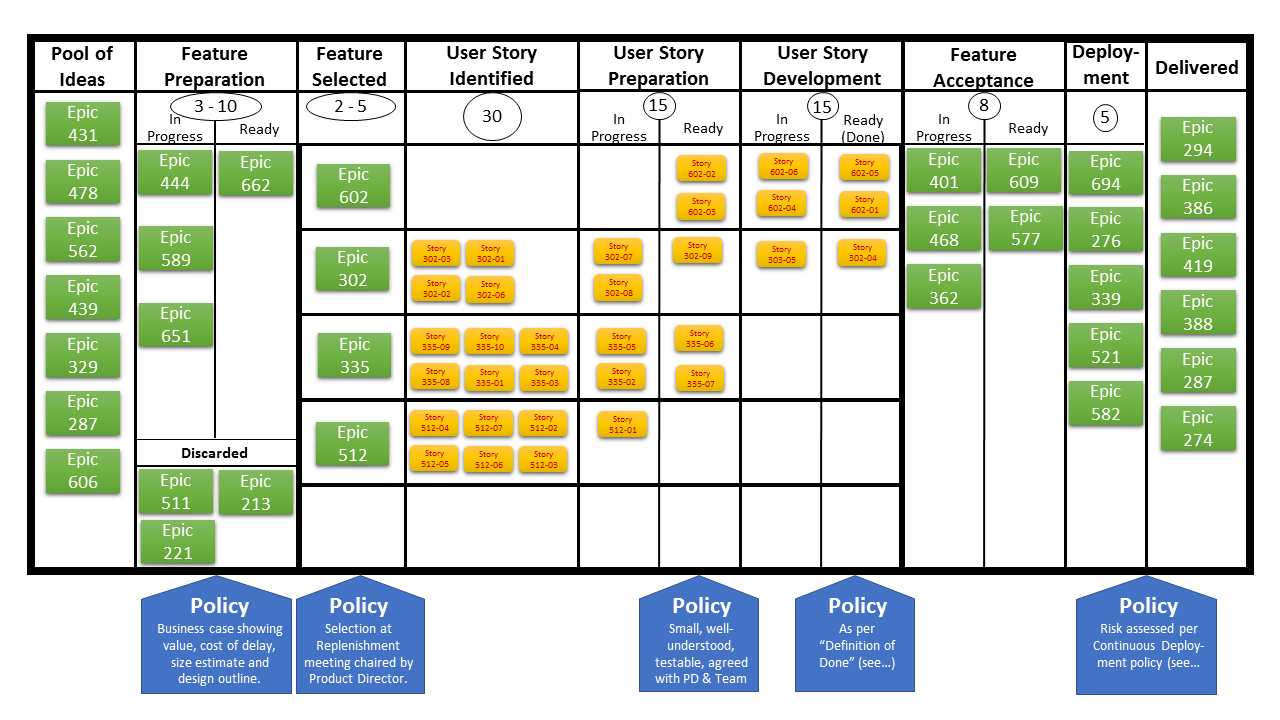|
Scrumban
Scrumban is an Agile aligned approach to product delivery which is a hybrid of Scrum and Kanban. Scrumban was originally designed as a way to transition from Scrum to Kanban. History As the Kanban method was becoming more popular , Scrumban was developed as an attempt to make it easier for existing Scrum teams to begin exploring Lean and Kanban concepts . The Method In Scrumban, the teamwork is organized in small iterations and monitored with the help of a visual board, similar to Scrum and kanban boards. To illustrate each stage of work, teams working in the same space often use post-it notes or a large whiteboard. In the case of decentralized teams, visual management software such as Assembla, Targetprocess, Eylean Board, JIRA, Mingle or Agilo for Trac are often use Planning meetings are held to determine what User Stories to complete in the next iteration. The User Stories are then added to the board and the team completes them, working on as few User Stories at a tim ... [...More Info...] [...Related Items...] OR: [Wikipedia] [Google] [Baidu] |
Scrum (software Development)
Scrum is a framework for project management with an initial emphasis on software development, although it has been used in other fields including research, sales, marketing and advanced technologies. It is designed for teams of ten or fewer members who break their work into goals that can be completed within time-boxed iterations, called ''sprints'', no longer than one month and most commonly two weeks. The scrum team assesses progress in time-boxed daily meetings of 15 minutes or fewer, called daily scrums (a form of stand-up meeting). At the end of the sprint, the team holds two further meetings: one sprint review intended to demonstrate the work done for stakeholders and elicit feedback, and one sprint retrospective intended to enable the team to reflect and improve. Name The term '' scrum'' is borrowed from rugby, where it is a formation of players. The term ''scrum'' was chosen by the paper's authors because it implies teamwork. The software development term ''sc ... [...More Info...] [...Related Items...] OR: [Wikipedia] [Google] [Baidu] |
Kanban (development)
Kanban (Japanese: , meaning signboard or billboard) is a lean method to manage and improve work across human systems. This approach aims to manage work by balancing demands with available capacity, and by improving the handling of system-level bottlenecks. Work items are visualized to give participants a view of progress and process, from start to finish—usually via a kanban board. Work is pulled as capacity permits, rather than work being pushed into the process when requested. In knowledge work and in software development, the aim is to provide a visual process management system which aids decision-making about what, when, and how much to produce. The underlying kanban method originated in lean manufacturing, which was inspired by the Toyota Production System. It has its origin in the late 1940s when the Toyota automotive company implemented a production system called just-in-time; which had the objective of producing according to customer demand and identifying ... [...More Info...] [...Related Items...] OR: [Wikipedia] [Google] [Baidu] |
Agile Software Development
In software development, agile (sometimes written Agile) practices include requirements discovery and solutions improvement through the collaborative effort of self-organizing and cross-functional teams with their customer(s)/ end user(s), adaptive planning, evolutionary development, early delivery, continual improvement, and flexible responses to changes in requirements, capacity, and understanding of the problems to be solved. Popularized in the 2001 ''Manifesto for Agile Software Development'', these values and principles were derived from and underpin a broad range of software development frameworks, including Scrum and Kanban. While there is much anecdotal evidence that adopting agile practices and values improves the effectiveness of software professionals, teams and organizations, the empirical evidence is mixed and hard to find. History Iterative and incremental software development methods can be traced back as early as 1957, Gerald M. Weinberg, as quoted ... [...More Info...] [...Related Items...] OR: [Wikipedia] [Google] [Baidu] |
Lean Software Development
Lean software development is a translation of lean manufacturing principles and practices to the software development domain. Adapted from the Toyota Production System, it is emerging with the support of a pro-lean subculture within the agile community. Lean offers a solid conceptual framework, values and principles, as well as good practices, derived from experience, that support agile organizations. Origin The term lean software development originated in a book by the same name, written by Mary Poppendieck and Tom Poppendieck in 2003. The book restates traditional lean principles, as well as a set of 22 ''tools'' and compares the tools to corresponding agile practices. The Poppendiecks' involvement in the agile software development community, including talks at several Agile conferences has resulted in such concepts being more widely accepted within the agile community. Lean principles Lean development can be summarized by seven principles, very close in concept to ... [...More Info...] [...Related Items...] OR: [Wikipedia] [Google] [Baidu] |
Kanban Board
A kanban board is one of the tools that can be used to implement kanban to manage work at a personal or organizational level. Kanban boards visually depict work at various stages of a process using cards to represent work items and columns to represent each stage of the process. Cards are moved from left to right to show progress and to help coordinate teams performing the work. A kanban board may be divided into horizontal "swimlanes" representing different kinds of work or different teams performing the work. Kanban boards can be used in knowledge work or for manufacturing processes. Simple boards have columns for "waiting", "in progress", and "completed" or "to-do", "doing", and "done". Complex kanban boards can be created that subdivide "in progress" work into multiple columns to visualise the flow of work across a whole value stream map. Applications Kanban can be used to organize many areas of an organization and can be designed accordingly. The simplest kanban boar ... [...More Info...] [...Related Items...] OR: [Wikipedia] [Google] [Baidu] |
Assembla
Assembla is a web-based version control and source code management software as a service provider for enterprises. It was founded in 2005 and acquired by San Antonio Venture Equity firm Scaleworks in 2016. It offers Git, Perforce Helix Core and Apache Subversion repository management, integrations with other enterprise software such as Trello, Slack and JIRA as well as the Cornerstone Subversion client for macOS. Assembla also offers integrations with customers' managed private clouds. History The company was officially formed in 2005, and was headed by Andy Singleton, creator of PowerSteering Software. Initially, Assembla offered free on-demand tools such as Trac and Subversion hosting. Assembla began charging for some of its products in October 2008. In 2012, Assembla partnered with Perforce Software to offer on-demand versions of Perforce’s Software Version Management tool, Helix Core, that is integrated with team tools from Assembla for an extra fee. In 2013, Assembla r ... [...More Info...] [...Related Items...] OR: [Wikipedia] [Google] [Baidu] |
Jira (software)
Jira ( ) is a proprietary issue tracking product developed by Atlassian that allows bug tracking and agile project management. Naming The product name comes from the second and third syllables of the Japanese word pronounced as ''Gojira'', which is Japanese for Godzilla. The name originated from a nickname Atlassian developers used to refer to Bugzilla, which was previously used internally for bug-tracking. Description According to Atlassian, Jira is used for issue tracking and project management by over 180,000 customers in 190 countries. Some of the organizations that have used Jira at some point in time for bug-tracking and project management include Fedora Commons, Hibernate, and the Apache Software Foundation, which uses both Jira and Bugzilla. Jira includes tools allowing migration from competitor Bugzilla. Jira is offered in four packages: * Jira Work Management is intended as generic project management. * Jira Software includes the base software, including a ... [...More Info...] [...Related Items...] OR: [Wikipedia] [Google] [Baidu] |
Agilo For Trac
Agilo for Trac (formally known as Agilo for Scrum) is an Open-source software, open source, web-based Scrum tool to support the agile Scrum (development), Scrum software development process. Agilo is based on Trac, a widely used Issue tracking system. It is programmed in Python (programming language), Python and is distributed under the Apache Software License 2.0. Its development was started in January 2007 by Andrea Tomasini while at agile42 and the first public version was released in January 2008. Since August 2011 it has been named to Agilo for Trac to emphasize its binding with Trac. Agilo is used in agile software development projects in all economic sectors who use the ''Scrum'' framework. The python application can be downloaded and used either as source tarball, python-egg, SaaS, a VMWare Virtual appliance or a Windows Installer. Version 0.8 is based on Trac 0.11, later versions on Trac 0.12. Starting from release 0.9.15 (1.3.15 PRO) Agilo for Trac is based on Trac 1.0 ... [...More Info...] [...Related Items...] OR: [Wikipedia] [Google] [Baidu] |
Bucket Size Planning
A bucket is typically a watertight, vertical cylinder or truncated cone or square, with an open top and a flat bottom, attached to a semicircular carrying handle called the ''bail''. A bucket is usually an open-top container. In contrast, a pail can have a top or lid and is a shipping container. In common usage, the two terms are often used interchangeably. Types and uses A number of bucket types exist, used for a variety of purposes. Though most of these are functional purposes, a number, including those constructed from precious metals, are used for ceremonial purposes. Common types of bucket and their adjoining purposes include: * Water buckets used to carry water * Household and garden buckets used for carrying liquids and granular products * Elaborate ceremonial or ritual buckets constructed of bronze, ivory or other materials, found in several ancient or medieval cultures, sometimes known by the Latin for bucket, * Large scoops or buckets attached to loaders and teleha ... [...More Info...] [...Related Items...] OR: [Wikipedia] [Google] [Baidu] |





